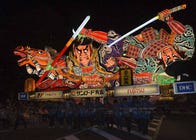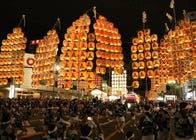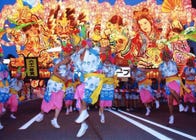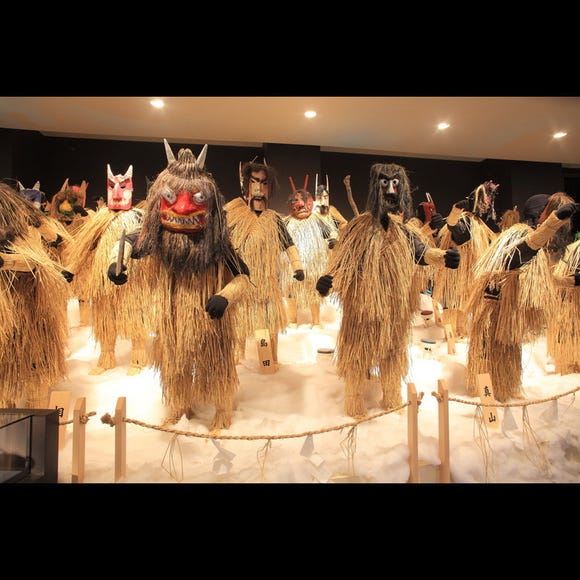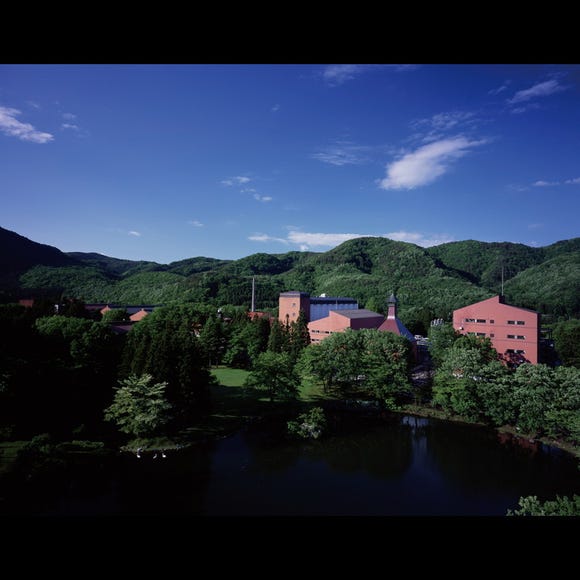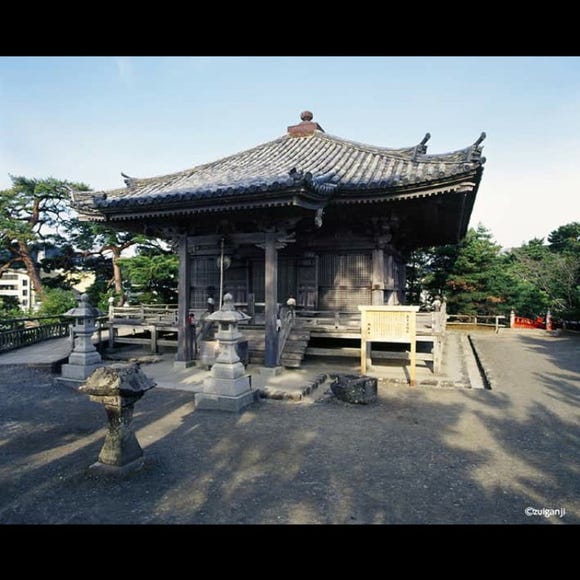
Coloring the streets of Aomori City every summer, the Aomori Nebuta Matsuri is one of the Three Great Festivals of Tohoku.
After two years of postponement, it made its grand comeback in 2022, charging the atmosphere of Aomori with eager anticipation. Before the festival commenced, LIVE JAPAN visited the local workshops to discover how the “nebuta” floats are made and to hear the passionate thoughts of nebuta craftspeople. We also learned how to fully enjoy the festival from the first ever Taiwanese Miss Nebuta!
- Table of Contents
-
- Status of the 2023 Festival Celebration
- The 2023 Aomori Nebuta Matsuri Event Schedule
- What is the Aomori Nebuta Matsuri?
- How Nebuta Floats are Made at the Nebuta Workshops
- How to Make the Most of the Aomori Nebuta Matsuri - According to the 2022 Taiwanese Miss Nebuta!
- Ways to Celebrate Aomori’s Giant Nebuta Festival
- How to Get to the Aomori Nebuta Matsuri
- Recommended Hotels for the Aomori Nebuta Matsuri
- Nebuta Matsuri: More Enjoyable if You Know the History and Process
Status of the 2023 Festival Celebration
From August 2nd to August 7th, 2023, for a duration of six days, a total of 17 grand Nebuta floats will illuminate the streets of Aomori. Each day, a different set of Nebuta floats will be in operation, but the most lively and vibrant days will be during the two-day period of August 5th and August 6th.
The 2023 Aomori Nebuta Matsuri Event Schedule
・Date: August 2-7, 2023
・Place: The streets of Aomori City (Shinmachi-dori Street, Heiwa Koen-dori Street, National Route 4 and 7, Hakko-dori Street
・Viewing Seats: Individual viewing seats (for up to 9 people) will be available for sale at convenience stores nationwide and other locations starting in early July. Details will be announced in mid-June on the official website.
- ・Pre-Festival Event:
- Date: August 1st
Time: 18:00-21:00 (tentative)
Venue: Special stage at Aoi-Umi Park
- ・Children's Nebuta Parade and Grand Nebuta Parade:
- Dates: August 2nd and August 3rd
Time: 19:00 onwards
Children's Nebuta: Approximately 10 floats
Grand Nebuta: Approximately 15 floats
Departure point: Starting from Nebuta Kyoudou Shoukousa-kouten intersection
- ・Grand Nebuta Parade:
- Dates: August 4th to August 6th
Time: 18:50 onwards
Number of floats: Approximately 20 floats
Departure point: Starting from Nebuta Shinmachi Yanagimachi intersection
Results Announcement: The results of the judging from August 2nd to August 5th will be tallied, and the Nebuta Grand Prize and other awards will be announced on August 6th. Visitors can view the award-winning Nebuta floats on this day.
- ・Grand Nebuta Parade:
- Date: August 7th
Time: 13:00 onwards
Number of floats: Approximately 20 floats
Departure point: Starting from Nebuta Shinmachi Yanagimachi intersectio
- ・69th Aomori Fireworks Festival and Nebuta Maritime Parade:
- Date: August 7th
Time: Approximately 19:15-21:00
Venue: Aomori Port
The award-winning Nebuta floats will parade at Aomori Port, adding a grand finale to the festival along with fireworks. Four floats are planned for the Nebuta Maritime Parade.
See the schedule on the official Nebuta website (English)
What is the Aomori Nebuta Matsuri?
The Aomori Nebuta Matsuri is one of Japan’s leading and most traditional summer festivals, taking place every August.
The “Nebuta” are giant lanterns, which can be as large as five meters in height and nine meters in length, and the lanterns, on floats, make their way around the city area, near JR Aomori Station.
Visitors from not just within Japan, but from Asia, America, Europe, and all around the world gather here to see these amazing sights.
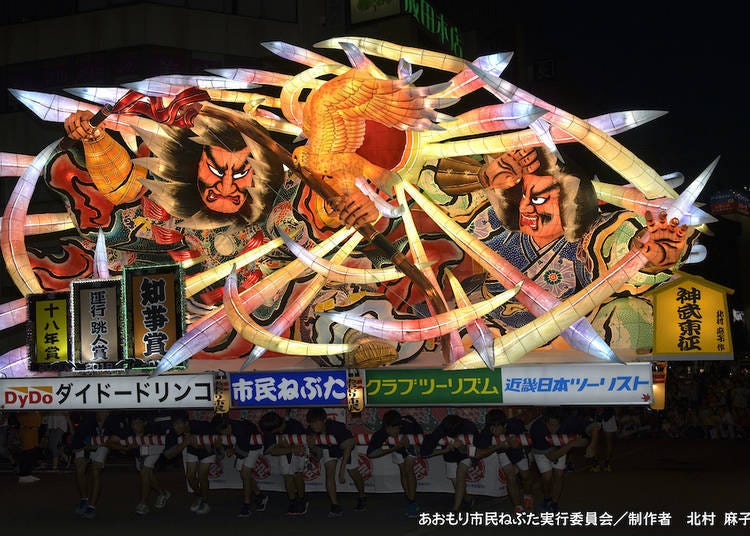
During the festival, the streets around Aomori Station (Shinmachi Dōri, Heiwa-Kōen Dōri, National Route 4, and Hakko Dōri, amongst others) are closed, and the Nebuta will be brought out to run down the center of these streets, in a 3.1-kilometer-long parade.
Beer and other street snack stores line the sides of the roads, making for an exciting experience as you walk down the street.
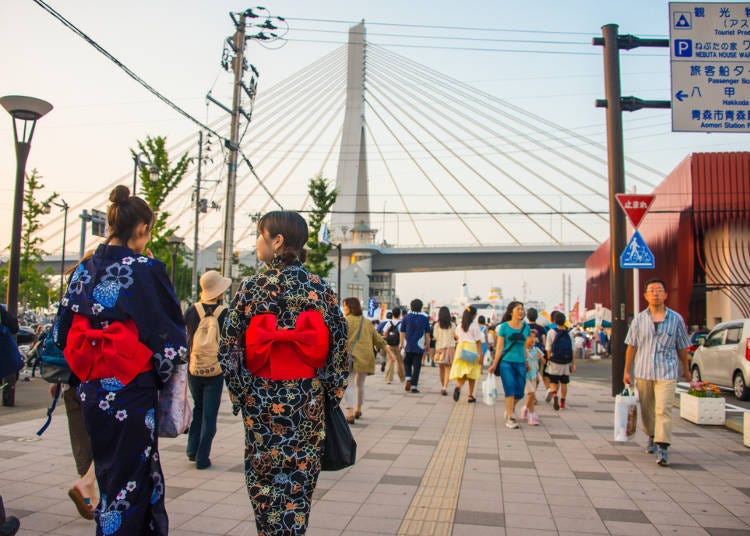
Though the origins of the Aomori Nebuta Matsuri are not exactly clear, it is believed to have originated from the Nara period (from 710 to 794), when the tradition of floating lanterns down streams during Tanabata, or the Star Festival, arrived from China and was altered.
To ward off the drowsiness that interferes with agriculture and farm work, lanterns and bamboo were floated down the rivers and oceans.
In Japanese, the word for “sleepy” is “nemutai,” and the word eventually evolved into “nebuta,” the name of the festival.
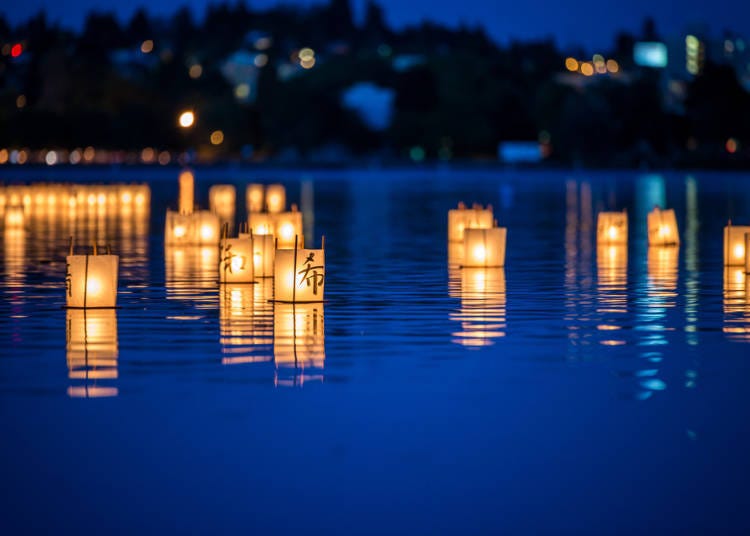
How Nebuta Floats are Made at the Nebuta Workshops
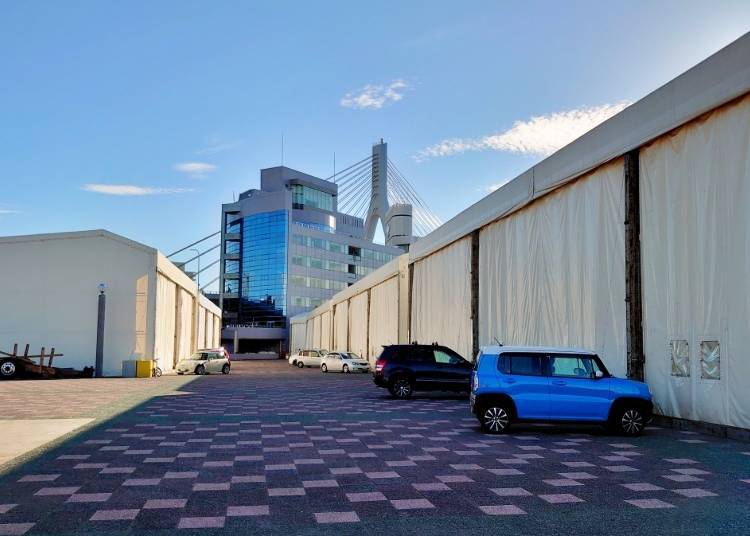
From the beginning of May each year, “Nebuta Rasse Land” appears at Aoiumi Park next to Aomori Port. This is where the workshops that build the nebuta floats are housed, which are painstakingly crafted from scratch each year.
This process takes around three months, with the nebuta masters and assistants working non-stop every day to ensure only the best are unveiled to the public.
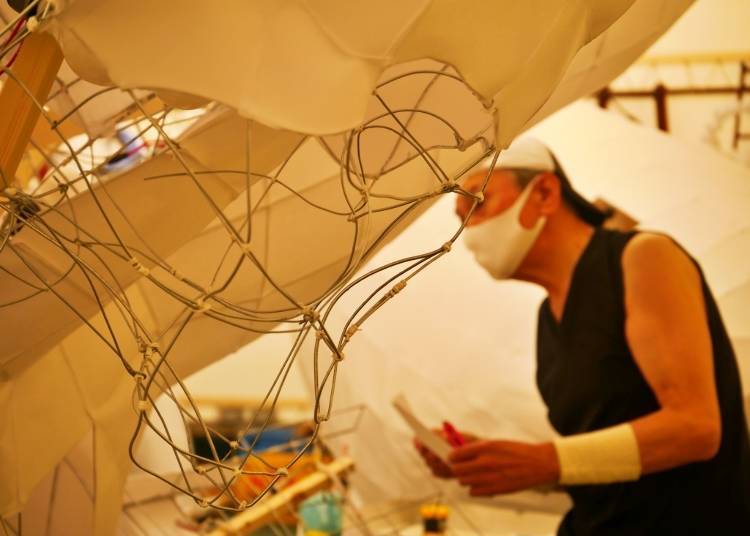
After stepping inside one of the tents, massive nebuta floats appear before us. Some have faces, while others are yet to be covered with paper. This particular tent is the workshop of the Nebuta Appreciation Society, where lovers of the art gather to raise funds by selling products and such, even in the absence of sponsors.

We interviewed Shin Suwa, the craftsman of the Nebuta Appreciation Society.
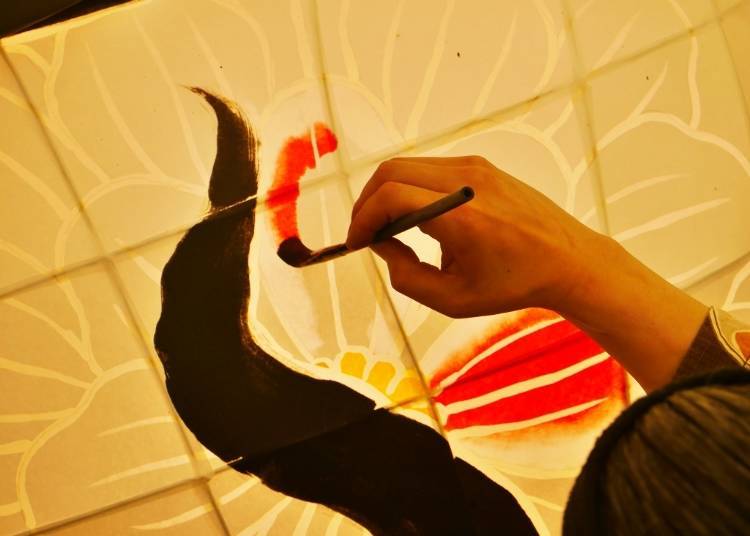
Everyone inside the tent was in high spirits. Painting, connecting wires, pasting on paper - all were working hard to bring their creation to life. For nebuta craftspeople, an essential element is imbuing a nebuta with their heart and soul to show people their passion.
“I want as many people to see our nebuta as possible,” said Shin as he added color to his creation. Never resting until satisfied, these impassioned craftspeople eagerly await the day when their handiwork will light up the streets, hoping that more and more people in Japan and the world can visit and discover its magic.
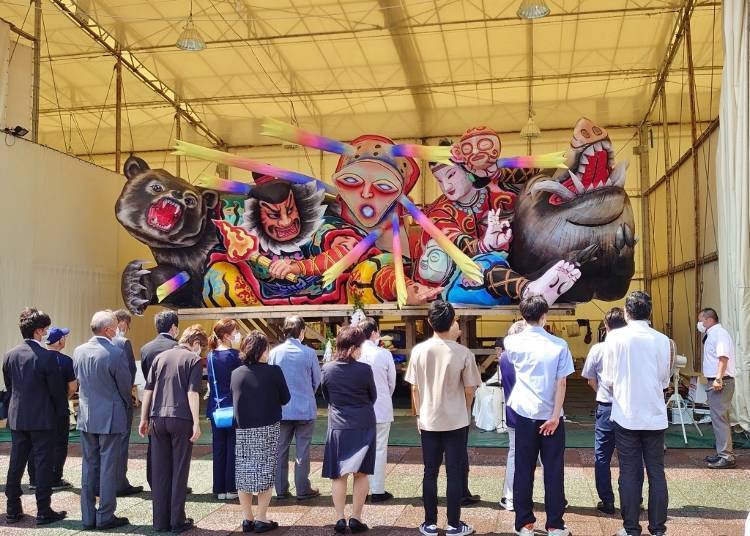
How to Make the Most of the Aomori Nebuta Matsuri - According to the 2022 Taiwanese Miss Nebuta!
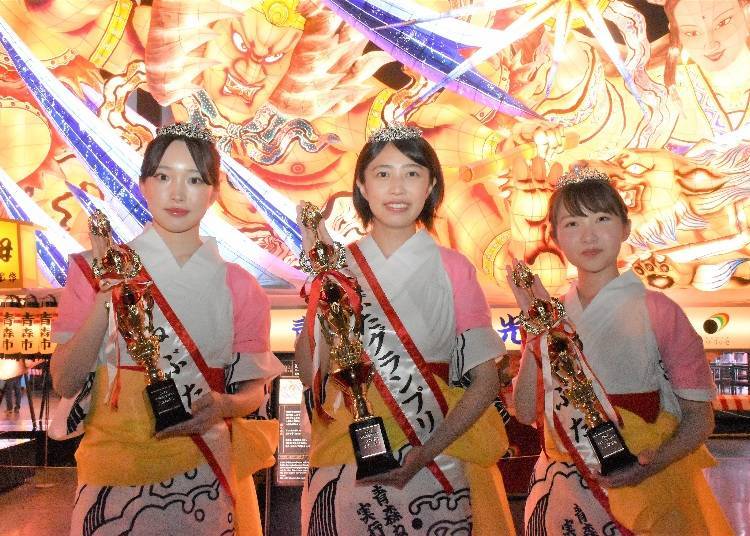
The duty of introducing the gigantic nebuta floats falls to “Miss Nebuta.” The Miss Nebuta contest began 50 years ago, with the winner serving as the tourism ambassador for the festival.
2022 marked the first-ever non-Japanese winner of the Miss Nebuta Grand Prix with Wu Yung-Hsin from Taiwan.
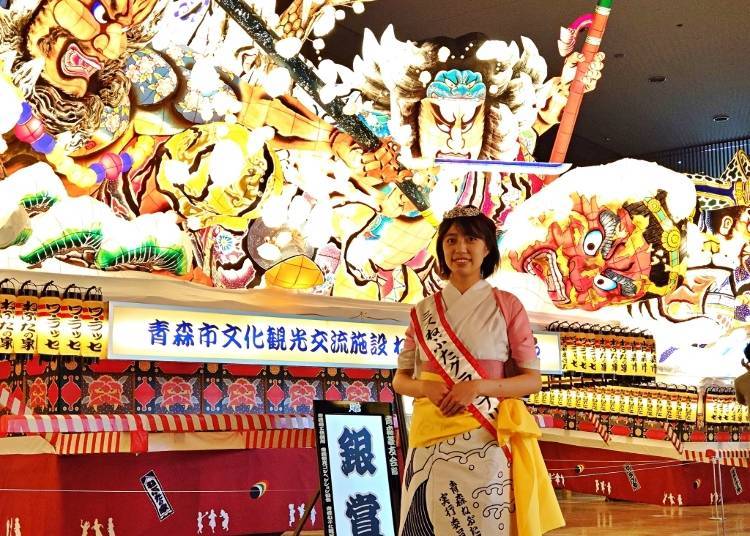
Wu Yung-Hsin came to Japan as an exchange student in 2015, moving to Aomori City in spring 2020 as a member of an international exchange team to introduce the culture and characteristics of Taiwan and Aomori.
She was hesitant when first hearing about the Miss Nebuta contest, but plucked up the courage to apply. After passing through written screenings and interviews, she was eventually selected as the 2022 Miss Nebuta among 12 finalists.
Despite her willingness to face the challenge, she was doubtful she’d get anywhere at first. “When I heard my name being announced, I was so shocked I couldn’t speak.”
“Being Taiwanese, I can communicate in several languages and help promote the charm of the Aomori Nebuta Matsuri to many people throughout the world.”
Displaying her abilities and confidence to the interviewers, it’s no surprise they decided to pick her to help lead the festival into a new age.
Asked how to make the most of the Aomori Nebuta Matsuri, Wu answered, “I recommend staying for two days and spending the night. On the first day, walk, explore the streets, and check out all the nebuta floats. On the second day, experience the festival’s energy through the haneto procession.”
“The nebuta floats themselves are really cool!” said a fired-up Wu. “They brim with force and vigor, and you’ll surely become spellbound seeing them sway back and forth.”
Wu says that if you have the chance to visit Japan in 2023, she strongly suggests lining up your trip with the Aomori Nebuta Matsuri.
Ways to Celebrate Aomori’s Giant Nebuta Festival
The Aomori Nebuta Matsuri is held for six days from August 2-7 every year. Everything from Nebuta lanterns made by local children to giant Nebuta makes their debut here.
The route that the floats take changes every day, and though you can see the floats no matter which day you head down to the festival, the 6th is especially recommended. In particular, there are performances by famous artists and a prize presentation for the creators of the floats, and on the 6th, you can see these prize-winning floats too.
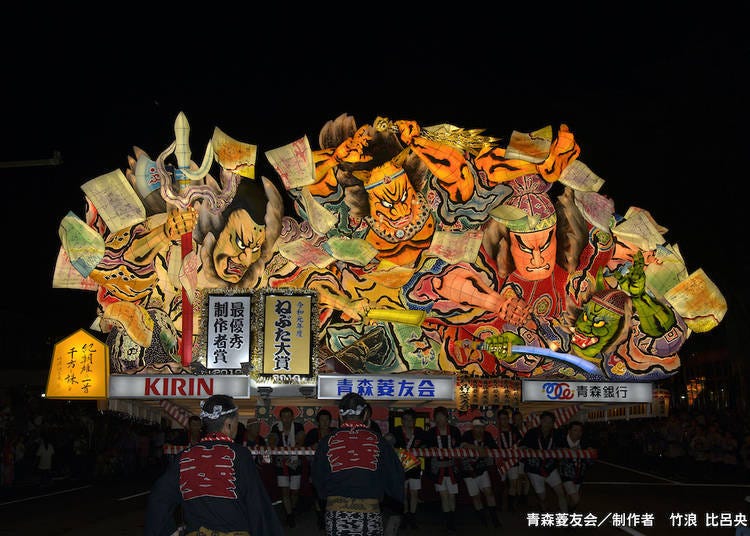
Besides this, the last day of the festival on the 7th will have the large Nebuta going down the streets during the day, and at night, the prize-winning Nebuta will be floated down the sea. The sight of the Nebuta lanterns coming and going on the water surface is very different from the sight of them on land and makes for an absolutely surreal image, so be sure not to miss it.

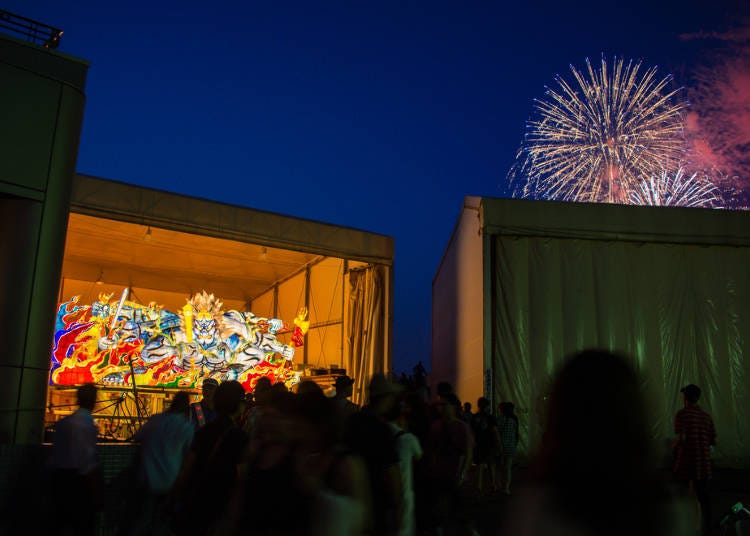
One more highlight of the Aomori Nebuta Matsuri is the “Haneto.” Wearing flashy and over-the-top outfits, they chant “rassera, rassera, rasse-rasse-rassera” as they jump and dance, further hyping up the atmosphere of the festival as dancers. With the carts carrying the Nebuta lanterns in the backdrop, the sight of their powerful dancing makes you want to hop in and dance with them side by side.
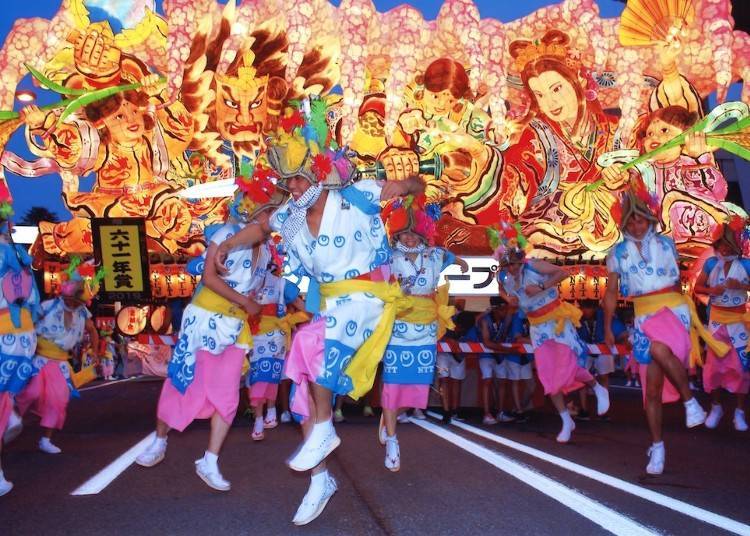
Though it’s mainly the Haneto whipping up the festival atmosphere, it’s actually possible for regular festival attendees to take part as well. Foreign visitors are more than welcome to participate, and there isn’t even a need to register beforehand.
All you have to do is wear the standard outfit of the Harneto, and wait at set points along the parade course before the start of the parade for your turn to join in.
The outfit can be purchased from the Aomori City Office for about 4,000 yen, though you can rent it as well. On the official site of the Aomori Nebuta Matsuri, the way to wear the outfit and places where you can purchase it are listed, and the rules are also explained in English, so feel free to participate.
If you really want to go all out at the festival, do take part in the parade with the locals as a Haneto. The locals will teach you how to dance the Haneto, and it’s an excellent way to foster new bonds with them while learning the dance from them.
However, the dance is very physically exhausting and will absolutely drain you, so be prepared for your legs to turn to jelly the next day.
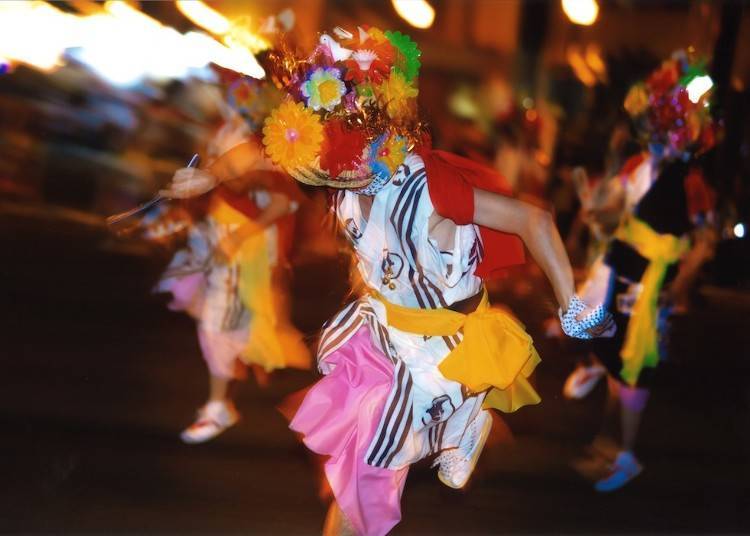
Other attractions gracing the festival include the clear sound of flutes and strong beat of taiko drums, along with the loud and unforgettable “shan, shan, shan” ringing of the teburigane, a type of cymbal.
The musical performances at the festival are called “hayashi”, and it is said that without them, the festival cannot be called the Aomori Nebuta Matsuri.
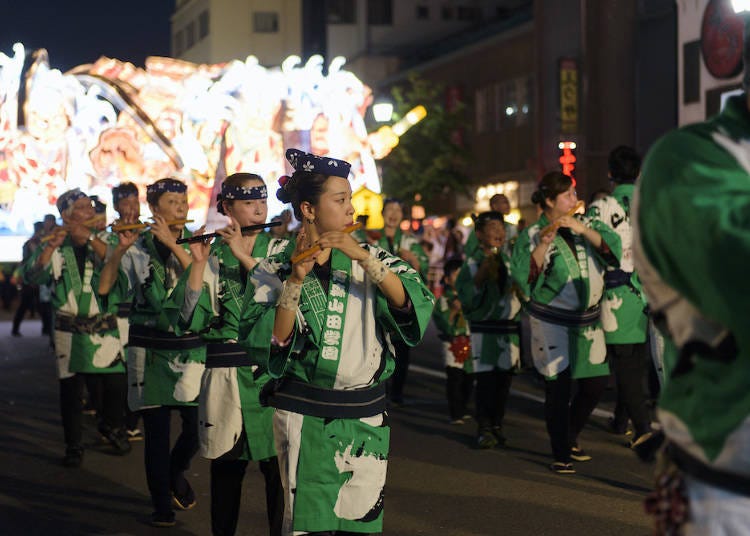
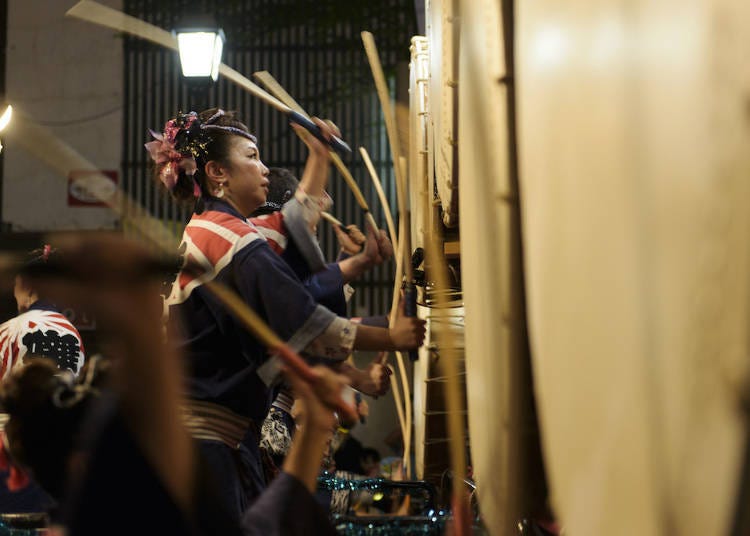
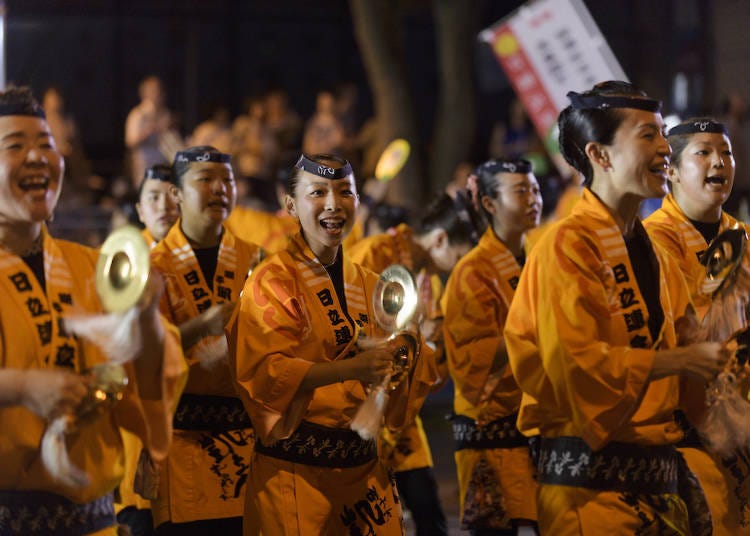
To the already impressive Nebuta lanterns, the Haneto and Hayashi join in to rile up the Aomori Nebuta Matsuri. For those who absolutely have to see everything up close, you can get a paid viewing seat from various ticketing services or the vending machines at the Aomori City Office.
All seats have assigned seating, at 3,500 yen (with tax; 2023 prices TBD) per ticket, and the pipe chairs and box seats allow you to get up close to the parade for a feel of just how truly magnificent it is.
Of course, you can view the Nebuta and Haneto, and enjoy the music of the Hayashi for free along the streets as well, though it can get rowdy and chaotic, making it easy for you to lose your companions. Do be careful not to get injured as well!
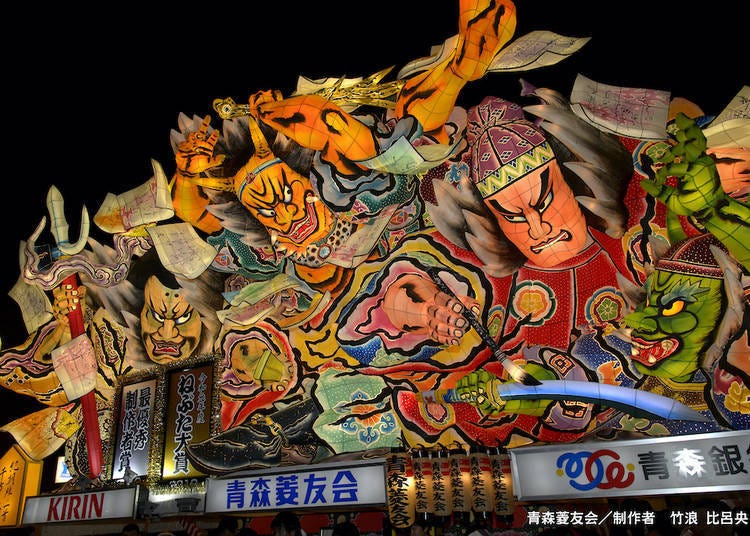
-
Aomori Nebuta Matsuri (Planning Committee Office)⻘森ねぶた祭(実⾏委員会事務局)
- Address 1-2-1 Aomorisyoukoukaigisyokaikan4F, Shimmachi, Aomori Shi, Aomori Ken, 030-0801, Japan
- Phone Number 017-723-7211
・Festival period: August 2nd to August 7th
・Festival timing: The schedule varies depending on the date. Please refer to the above "2023 Festival Schedule" for more information on specific dates and times.
・Admission fees: Free. Seated viewing at 3,500 yen (with tax; 2023 prices TBD) per seat; reservations required.
How to Get to the Aomori Nebuta Matsuri
When visiting the Aomori Nebuta Matsuri, we recommend taking the Tohoku Shinkansen bullet train from Tokyo Station to Shin-Aomori Station, then changing to the JR Ou Main Line until Aomori Station.
The Aomori Nebuta Matsuri is held very close to the station, so you shouldn’t have trouble finding it. Nebuta Rasse Land and the nebuta procession route are also in the residential areas around the station, making the trip totally walkable.
Step 1: Tohoku Shinkansen from Tokyo Station to Shin-Aomori Station (Approx. 3 hrs - 3.5 hrs)
Step 2: JR Ou Main Line from Shin-Aomori Station to Aomori Station (Approx. 6 mins)
Those with international passports can also use the JR EAST PASS (Tohoku area).
Recommended Hotels for the Aomori Nebuta Matsuri
As the Aomori Nebuta Matsuri is held around Aomori Station, hotels and other accommodations are plentiful. Transportation is also a breeze, and many rooms boast direct views of the processions from their windows. Of course, rooms fill up quickly, so we recommend booking as early as possible.
If you can’t book a hotel in Aomori City, there’s still hope! Using the JR EAST PASS, you can freely and easily take the train to nearby cities like Hirosaki, Goshogawara, and Hachinohe and spend the night there.
You can also stay in the hot spring resort town of Asamushi Onsen, which is around 30 mins by car or train from Aomori City, making for a more relaxing and memorable trip!
-

-
Address
Asamushi Onsen Tourism Association, 70 Asamushi Hotarudani, Aomori City, Aomori Prefecture, 039-3501
View Map -
Nearest Station
Asamushionsen Station (Aoimori Tetsudo)
20 minutes by car
- Phone Number 017-752-3250
-
Address
Asamushi Onsen Tourism Association, 70 Asamushi Hotarudani, Aomori City, Aomori Prefecture, 039-3501
Nebuta Matsuri: More Enjoyable if You Know the History and Process
For sightseers who plan to see the Nebuta at night, you can spend the daytime exploring the surrounding facilities, and learning more about its history and the construction process of the Nebuta, for a more enjoyable festival experience.
For example, a one-minute walk away from JR Aomori Station is Nebuta Museum WA-RASSE, a museum that highlights the history and draws of the Nebuta Festivals, and has an information corner where you can learn about the origin and history of the festival from the large Nebuta on display, and even an event space where you can experience the Hayashi and Haneto for yourself.
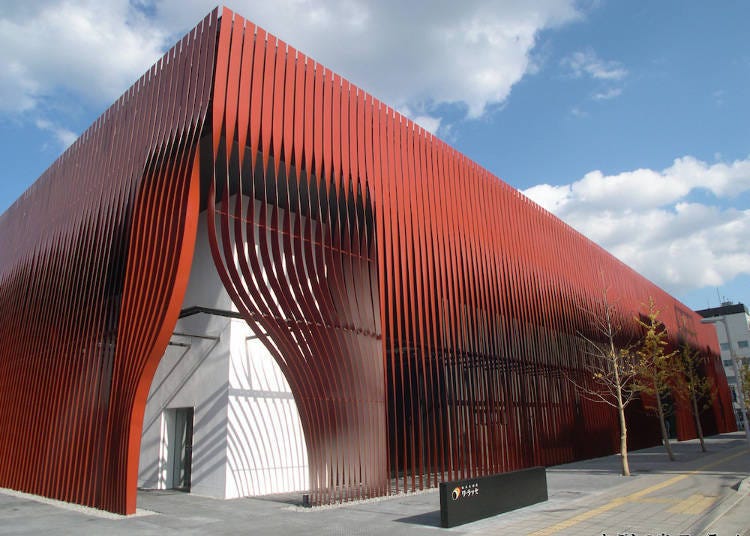
The explanations on the exhibits inside are available in English, Chinese, and other languages as well. Recently, a translation system that allows you to scan a QR code with your smartphone to view information about the Nebuta in your own language was also implemented.
With multi-language support, you can have fun without any worries. The place is open all year round, and it’s recommended to try out the Nebuta Matsuri experience during the off-season too.
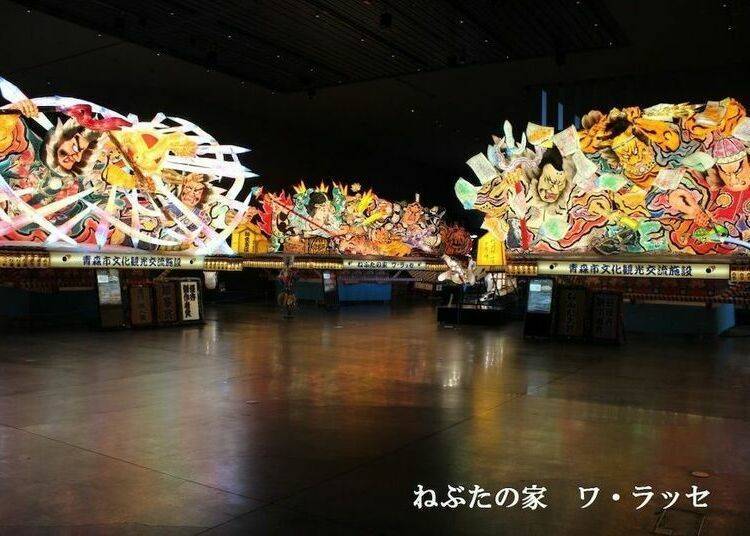
On top of that, about eight minutes away from JR Aomori Station is “Nebuta Rasse Land” in Aoiumi Park. Every year from spring to summer (until August 6), around 20 large Nebuta are lined up for display. You can see the pristine state of the Nebuta before departure up close, and seeing them while taking in the ocean view is an enjoyable activity indeed.
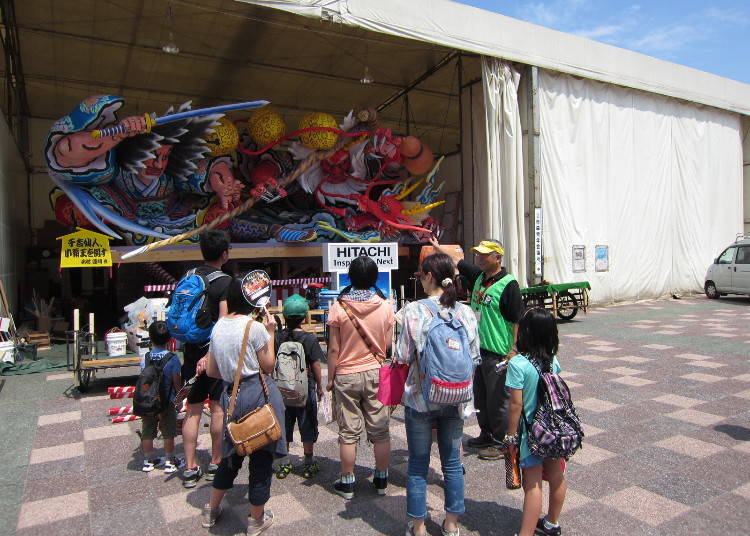
Rather than simply watching the Aomori Nebuta Matsuri, learning about its origins and history, and participating in various experiences will make your first visit there 100% more enjoyable.
Hype yourself up at the festival with the locals, and have an unforgettable six days together. Foreign language support is available as well, so do be sure to come and enjoy Tohoku’s largest festival!
-
Nebuta Museum WA-RASSE (Nebuta Museum, Nebuta Hall)ねぶたの家 ワ・ラッセ(ねぶたミュージアム、ねぶたホール)
- Address 1-1-1, Yasukata, Aomori Shi, Aomori Ken, 030-0803, Japan
- Phone Number 017-752-1311
・Hours: 9:00 a.m. to 7:00 p.m. (Until 6:00 p.m. from September to April)
・Closed on August 9th and 10th, December 31st, and January 1st
・Admission: 620 yen for adults, 460 yen for high school students, 260 yen for elementary and middle school students
-
Nebuta Rasse Landねぶたラッセランド
- Address 1 Chome-2-1 Yasukata, Aomori, 030-0803
- Phone Number 017-735-8750
・Period: July 1 - August 6
・Hours: 10:00 a.m. - 3:00 p.m.
・Free entry
Text by: Tsubasa Shimoda, craftspeople and Miss Nebuta interview + 2022 updates by Shitamachi Kizoku
*This article was originally published in April 2020, and updated in May 2023. Always confirm the latest information on official websites, etc.
*Prices and options mentioned are subject to change.
*Unless stated otherwise, all prices include tax.
Limited time offer: 10% discount coupons available now!
-
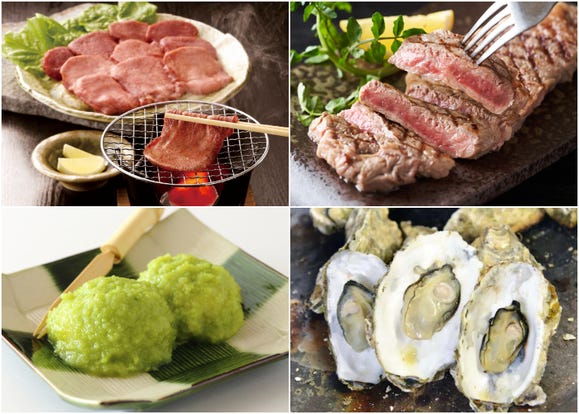
Where to Eat in Sendai: Best Sendai Foods to Try & Tasty Restaurants
-
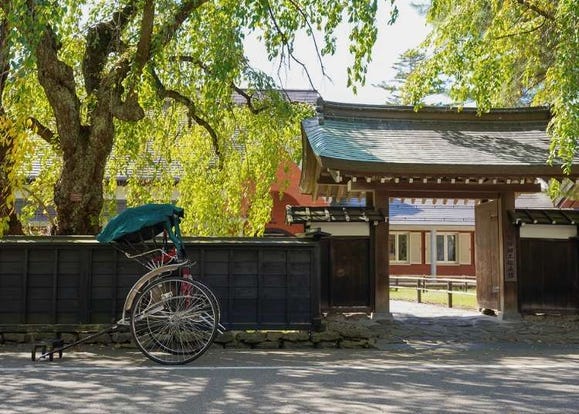
Travel Guide to Kakunodate: Akita's Charming Historic Town Featuring Samurai Residences & Weeping Cherry Blossoms
-
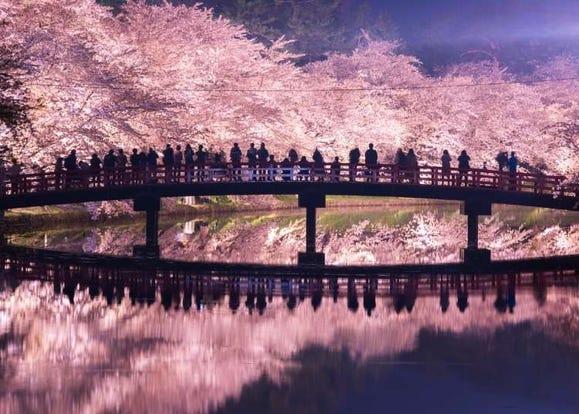
Where To Stay in Aomori: Best Areas & Hotels for Visitors to Japan's North
-

Complete Guide to Kagura Ski Resort (2023): Explore Niigata’s Huge Skiing Paradise
-
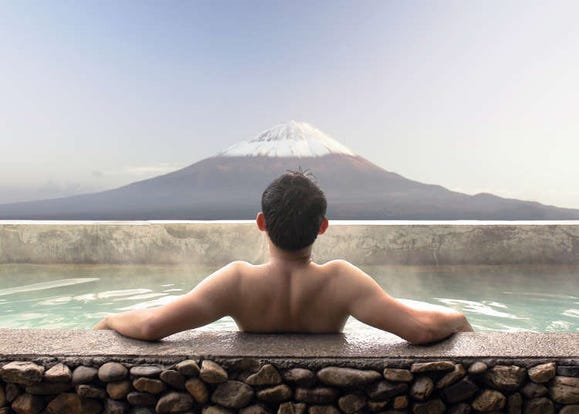
Japan's Bath Culture: Tips You Should Know!
-
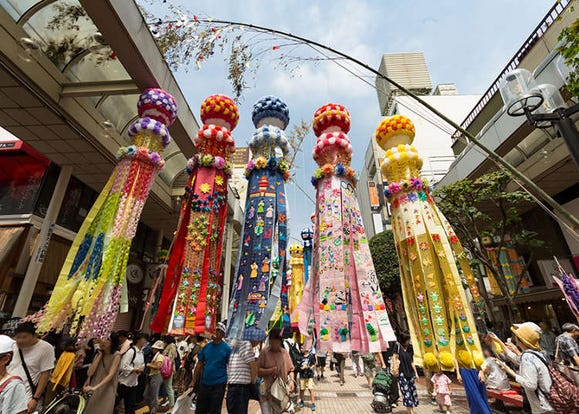
Enjoy the Magic of Sendai's 2023 Tanabata Festival (Aug. 6-8): A Must-Read Guide for Travelers
-
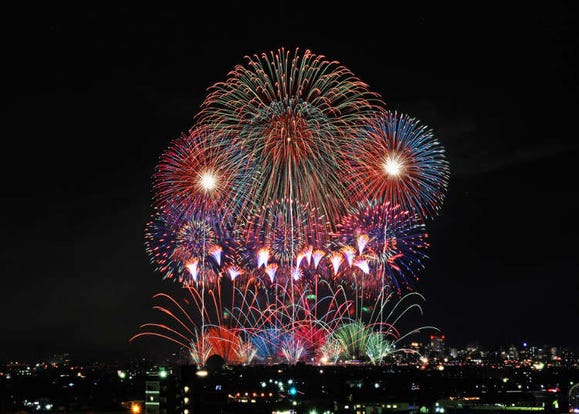
'Like Flowers Blooming at Night' Expats Reveal 5 Surprising Things About Japanese Fireworks Festivals
-
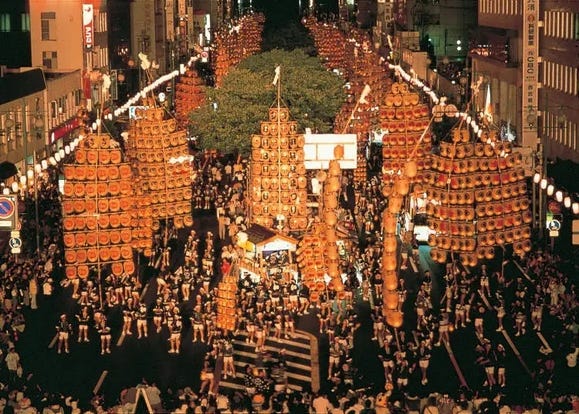
Nebuta, Kanto, and Tanabata – Discover the Three Great Festivals of Tohoku (August)













